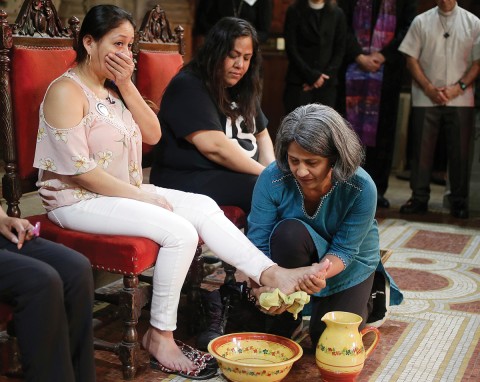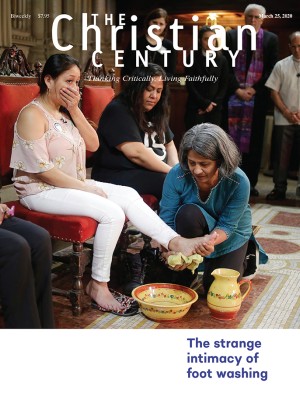The strange, humbling ritual of foot washing
It makes me uncomfortable. That’s by design.

From the expression on the face of the priest at the Maundy Thursday service, I figured foot washing might be his least favorite activity of the church year. His face was wrinkled in what looked like disgust, as if he had just realized anew that this ritual involved actual feet.
When I approached the altar barefooted, as we had been instructed, he dabbed my feet lightly with a cloth before moving on to the next person in line. I returned to my seat and was surprised by the depth of my emotion. I felt dismayed, alienated, even distraught. I felt the priest’s disgust, whether real or imagined, viscerally and personally. I vowed never to return to that church or to that priest.
Read our latest issue or browse back issues.
I had been a stranger there and had wandered in on Maundy Thursday to connect with the traditions of Holy Week. Despite the fact that I had spent most of my life in nonliturgical churches, the idea of Lent and Holy Week had made an impression on me. That idea of a sacred time for reflection followed by a slow walk toward Easter had settled deep into me, and though I rarely went to church in those days I still sought church out during Holy Week, specifically looking for where I might get my feet washed or wash the feet of someone else.
Almost everyone has feet, yet feet have an uncanny quality. After decades now of being involved in foot washing, I have noticed that people frequently apologize for their feet, if they are willing to expose them at all. People tend to find their own feet unsightly: knobs, calluses, bunions, corns, misshapen toes, warts. Most of us keep our feet covered most of the time. To have our feet exposed, washed, even touched by a stranger in the context of church is an act of great vulnerability. It seems like a bad idea to many people. What was Jesus thinking?
I can understand why—despite Jesus’ admonition in John 13 that his disciples wash one another’s feet—some churches in recent years have substituted hand washing for foot washing. The participant is far less vulnerable. And many churches simply gloss over this admonition as though Jesus was speaking only metaphorically.
Whatever our objections to foot washing, Jesus’ disciples voiced their own resistance. “You will never wash my feet!” Peter says to Jesus. I have seen dozens of people with this same reaction. Each person’s reasoning may be different, but the assertion is the same. “Not my feet.”
But Jesus has a powerful retort: “If I do not wash you, you have no part with me.” These are strong words, suggesting that Jesus’ command to wash one another’s feet ranks pretty high in his list of commands, right up there with “Love one another.” I’ve felt instinctively that Jesus’ command does indeed involve actual feet and actual, not symbolic, washing. For us as much as for Peter, it is meant to be about a physical experience that provokes discomfort.
The history of the church does not necessarily confirm this instinct of mine. To me foot washing has a sacramental quality—a place where heaven meets earth, where the scandal of the incarnation is as vivid and present as it is in the Eucharist. But foot washing has never been a sacrament. In fact, church historians have found no instances in which the idea of foot washing as a sacrament was even considered.
John’s Gospel is the only one to mention foot washing. The passage in John begins with the briefest mention of the supper that would become so central to the Christian tradition. Instead, the passage introduces foot washing via a declaration of Jesus’ love in the context of the betrayal that will lead to his death. “And during supper, Jesus, knowing that the Father had given all things into his hands, and that he had come from God and was going to God, got up from the table, took off his outer robe, and tied a towel around himself.”
The presence of this story in this location in the Gospel has led some scholars to conclude that there was probably a communal foot washing ritual among early Christians. But Andrew McGowan, a scholar of early Christianity at Yale University, says that evidence for such an early tradition is scant to the point of nonexistent. Foot washing itself was common enough. Women and servants were frequently called upon to wash the feet of high-ranking men. But a specific communal practice that enacted a reversal of power, displaying Jesus’ “humility and intimacy” as McGowan puts it, did not leave a mark on the historical record—except in this story in John.
McGowan suggests that the best context for understanding foot washing among first-century Christians is a practice that involved Christian women and prisoners. There is evidence that Christian women frequently went to prisons and other locations where marginal and disgraced individuals could be found and washed their feet. This practice was not highly regarded by those outside the Christian community and was criticized by some. It was considered improper and unseemly, especially since many of these women were not themselves poor or imprisoned.
McGowan speculates that the story in John 13 may originate in an effort to “defend the awkwardness of women entering spaces outside the private sphere to undertake ritual washing.”
Charitable foot washing disappears as a practice by the fourth century. Foot washing of another kind surfaces around the same time—as a somewhat controversial initiation rite among Christians. This rite was practiced in Milan under Bishop Ambrose. Arguments about whether clergy should or should not ritually wash the feet of the newly baptized suggest that the practice was observed at other places. This is the only known ritualization of the text in the early centuries of Christianity.
Another foot washing practice developed later in monasteries. In this ritual, foot washing was offered by brother to brother or abbot to brother. John Cassian describes a practice in which brothers who had done especially difficult or meaningful work on behalf of the monastery had their feet washed by other monks as a gesture of gratitude.
In the Middle Ages, monarchs and bishops and sometimes popes would choose subjects whose feet they would wash in public rituals. The current practice in the Catholic Church in which the pope chooses 12 people and gathers them for a Maundy Thursday ceremony in which he washes their feet has only been in place since the 1950s; it is a recent ritualization of the text of John 13, not the continuation of an ancient tradition.
After the Reformation, Protestants began to develop ritual practices of foot washing. Queen Elizabeth I washed the feet of poor women. The Moravians of the 16th century made foot washing one of their central practices and have maintained it ever since. Moravian scholar Craig Atwood writes that foot washing is one of the practices whose “primary purpose was to strengthen the ties among members of the community.” Foot washing was performed only in same-sex groups and sometimes only the leader did the washing. At other times, all members washed each other’s feet. Atwood writes that the rite, called the pedalavium, was for the Moravians “an invisible grace, akin to a sacrament, in which the Watchers (or angels) participate.”
After the Second Vatican Council, foot washing was revived as part of the liturgical renewal in Methodist, Presbyterian, Lutheran, and Anglican and Episcopal churches. It came to be included as an option in official worship books. Lutheran liturgist Frank Senn urges Protestants to include foot washing in their contemporary ministry because it “encourages bodily engagement in liturgy,” which was precisely the point of liturgical renewal.
Groups like L’Arche, a ministry with people of different intellectual abilities, have incorporated foot washing as a way of expressing common humanity and humility as they build Christian community. Other ministries imitate the charitable foot washing practices of the first century by washing and tending to the feet of homeless people. Foot washing is fairly widespread in Christian life today, varying in frequency and in how the practice is actually carried out.
I did not know any of this history when I was looking to join a church community. But I knew it had to be a church with a robust practice of foot washing. There could be no dabbing, no looks of disgust, no wishing that the practice would go away. I needed a lived theology of foot washing.
That’s what I found at St. George Episcopal Church in Leadville, Colorado. On Maundy Thursday, we encourage people to leave their shoes at the door. We carry big tubs of warm water into the sanctuary. In washing feet we use handmade soaps, and we offer to apply lotion at the end. We walk an odd line between a ritual foot washing and a pedicure. Foot washing is essential to our theology of hospitality and incarnation; it is a concrete way that we live out our mission to “seek and serve Christ in all persons.”
Very often the offer of foot washing is refused. People don’t want to have their feet washed because it’s awkward, it’s weird, and it makes the recipient feel vulnerable. But when people do accept the task of washing one another’s feet, a strange and beautiful magic unfolds.
Take the story of Brian. Brian arrived for his first Maundy Thursday service straight from the woods, where he had been camping for the better part of the winter. He was hungry and dirty and quite anxious about how his feet and his whole body would be received. He apologized as he sat next to me at the meal that we had spread out in the sanctuary, but he ate gratefully.
After supper, he said no to the foot washing but sat on the side to watch the proceedings. He became intrigued and decided that foot washing might actually feel pretty good on his tired and aching feet.
That day began Brian’s life in the community. He became a regular volunteer at the community meal the church serves. He became the person to grab the church laundry and bring it back clean. He made food deliveries. His life began to echo Jesus’ words in John 13, “If you know these things, you are blessed if you do them.” The knowing began with warm water and a personal risk, and it grew from there.
Foot washing at St. George retains, after all of these centuries, a hint of scandal. One year, a homeless man named Kenny joined us for all of the rituals of Holy Week. Even though he was still drinking heavily (and would soon die of liver failure), he had started to attend church with a quality of faithfulness that was no longer about his seeking our help.
At the foot washing, he ended up seated next to the priest’s tiny sprite of a daughter, who was about five years old. I felt some anxiety when I saw it, for it meant that as we went around the circle, with each person washing the feet of the person next to them, Lara would wash Kenny’s feet. I worried for them both. Would she refuse to wash Kenny’s feet? That would be completely understandable, but potentially humiliating for Kenny. Would he refuse to have his feet washed? That had happened so often I could almost anticipate it, but Lara would probably misunderstand it.
But when it was Lara’s turn, she knelt down at Kenny’s feet as if it were the most natural thing in the world. She lifted Kenny’s feet into the basin of warm water, put soap on her hands, and washed his feet. Kenny laughed nervously and then began to cry. Then everyone began to cry, except Lara, who continued her work in a businesslike manner with deliberate movements. She spread lotion on his feet with interest and attention, as if painting with finger paints.
Each year, foot washing produces a new strangeness, and the children perceive this more than anyone. One year, a child decided to go into the kitchen and get her own basin and her own stack of towels. Everyone got two foot washings that year. Another year, children crawled around on the floor sniffing everyone’s feet and giggling. Another year, my son came home from foot washing and announced that he was going to wash the feet of my husband, who had stayed home. He filled the dishpan with water and brought it to the TV room and washed my husband’s feet in front of the beanbag chair.
The children perceive something essential about foot washing, something that is perhaps outside of the debate about its place in church tradition: the combination of playfulness, incarnation, and marginality, the fact that foot washing can be re-invented again and again. That is precisely what gives it power. Conducted out of a sense of obligation (as in the case of that poor disgusted priest years ago), the ritual loses its potency and its healing power. By its very nature, it is a ritual that must be freely given and received in all its permutations of humility and intimacy.
A version of this article appears in the print edition under the title “A strange, humbling ritual.”






